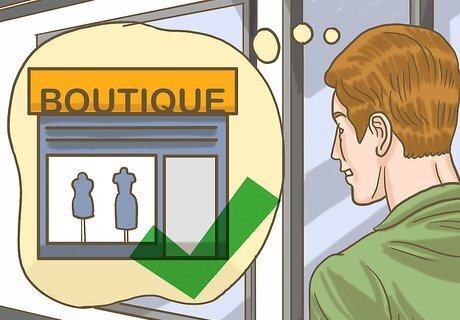
views
Planning Your Boutique

Decide what type of boutique you want to open based on your interests. There are high-end fashion boutiques that sell clothes from top designers, modern fashion boutiques that sell popular brands, and boutiques that sell children's clothes. Pick what you're passionate about. For example, if you love piling on costume jewelry and scarves when you go out, you might enjoy running an accessories boutique. Be careful about choosing too narrow of a niche. Appeal to as many customers as possible by keeping it more broad. So instead of a store that sells exclusively cat T-shirts, open one that sells a range of quirky tees and tops. You can even sell your own designs if you have dreams of becoming a jewelry or fashion designer.

Choose a location with the best traffic, visibility, and price. You want to be in a spot that has a lot of potential customers and where your store will be easy to find and get to. The rent or lease price also needs to be in your budget. Spend time scouting different locations before you settle on one. Think about the kind of customers you want. If you're selling to college students, find a spot within walking distance of campus, for instance. Keep in mind that trendier, downtown areas will come with much larger price tags. Consider opening in an up-and-coming area that may be slightly cheaper but still have potential. Get a second opinion from a real estate professional. They can provide valuable insight into which areas are the best bang for your buck and which ones to avoid.

Evaluate the competition in your area to guide your own planning. Find out what other boutiques or stores that sell similar products are closeby. Look at what they're selling, what their prices are, and how they're marketing their business, for starters. Incorporate some of their strengths into your own business plan and figure out how you can improve on their weaknesses. For example, if they have a successful social media giveaway campaign, think about making social media a big part of your marketing strategy. If you see comments online ranting about a nearby boutique's outrageous prices, consider setting yours a little lower. Use their mistakes to make your business better. Studying the competition will also help you understand your target customer. Spend a day browsing your competitors' stores and analyze the type of people shopping there along with their shopping habits.

Write a business plan to define your goals and act as a blueprint. Clearly state your boutique's mission and primary goals, then document every detail related to making your business successful, like costs, staff, inventory, supplies, marketing, and more. The more detailed and granular you get with your plan, the better prepared you'll be moving forward. The 7 Main Sections of a Business Plan Executive Summary: Briefly summarize the business plan. Company Description: Explain what your boutique is and why it will be successful. Market Analysis: Examine your competition and where you fit into the industry. Organization and Management: Describe the structure of your company. Products and Services: Provide specific information on what you're selling. Marketing and Sales: Lay out your strategies for growth and new business. Financial Projections: List your financial goals for the boutique.
Securing Funding

Meet with an accountant to determine the viability of your business plan. Getting professional financial advice from an accountant is worth the extra cost. They can help you figure out a realistic budget and pricing structure for your boutique based on your business plan. If anything sounds unrealistic financially, they'll let you know so you can avoid making a costly mistake. An accountant will also be able to explain what taxes you'll be responsible for, how different decisions will affect your bottom line, and any accounting issues unique to your industry. Choose a certified public accountant (CPA) who is skilled at generally accepted accounting principles (GAAP).

Ask the bank about a small business loan if you're willing to take a risk. Some banks offer loans to entrepreneurs, although they're often in smaller amounts because of the high risk involved. The bank will require documents like your business plan and detailed budget along with personal financial information. Make an appointment at your local branch to find out what's available. Having a good credit score of 680 or higher will improve your chances of getting approved. Loans are risky because you'll have to take on the repayment debt yourself if your boutique fails.

Pitch angel investors or venture capitalists using your business plan. Venture capitalists invest money from a venture capital firm whereas angel investors are often wealthy individuals looking to put their own money towards new opportunities. With a well-written business plan and a little charm, you can exchange stake in your boutique business for funding. Look for investors online or ask friends and family if they know of anyone. If you're working with an accountant, they also might have recommendations. Do your research first. Since you're just starting out, look for smaller, local investors who have been involved in ventures similar to your own in the past.

Use your own personal savings if you have 1 year of expenses set aside. Entrepreneurs often dip into their own bank accounts to fund their ventures. But you need a safety net in case it fails. A good rule of thumb is to have enough saved up that you can cover at least 1 year of your personal living expenses first. Consider taking a part-time job to bank a few extra bucks if you have time during the early stages of planning your boutique. You might have to forgo taking a salary for yourself during the first few months of your boutique so having enough savings to live off of is important.
Setting Up Shop

Interview and hire employees if you need more help. Unless your boutique is super small, you'll likely want extra hands. Post fliers around town, put an ad up on an online job site, or spread the word that you're hiring. Host interviews to screen your candidates and select the ones who you like and who you think would be reliable and hardworking. Always run a background check and check a potential employee's references before extending an offer. Sample Interview Questions for Sales Associates Tell me about yourself. What are your strengths? Your weaknesses? Why do you want to work here? Tell me why I should hire you instead of someone else. How would you deal with an upset customer? Where do you see yourself in 5 years? What gets you out of bed in the morning? What would your former coworkers say are your best qualities? Do you have any questions for me?

Order just enough inventory to stock your shelves for the first month. As a new boutique owner, you aren't sure exactly how much of each product you're going to sell, so ordering can be tricky. The goal is to have enough that you aren't selling out but not so much that you're left with too many in the back. Order based on your sales projections for the first month in your business plan. Ask the company you're ordering from if they have a suggestion. They'll often have industry knowledge that they're willing to share with newcomers. Find out if the supplier has a return policy in case you over-order. Err on the side of ordering too much. After all, if you sell out, you'll be turning away potential customers!

Furnish and lay out your boutique in a way that flows well. Customers should be able to shop freely without bumping elbows so keep aisles wide enough for 2 people to pass through. Fill the space with racks and eye-catching displays so it doesn't feel empty, either. Zones, which group similar products together, also make shopping easier for customers. Place your most expensive pieces or the pieces you think will sell best to the right of the entrance. Add a “decompression area” just inside the door as a transition space. It should be inviting, free of clutter, and give customers a chance to survey the entire store. When it comes to furnishings, don't forget the staples like a cash register and sales counter.

Create a clean, inviting storefront to draw in customers. Your storefront is the first impression customers get of your boutique. Pretty it up with beautifully-designed window displays, ample lighting, or potted plants. Keep it clean and free of trash and debris by regularly sweeping the outside entrance. Change up window displays once every 2 weeks to create visual interest and attract new customers. Check your local regulations before adding any permanent structures like awnings or changing the front of the building with paint or other repairs.
Marketing Your Boutique

Design a basic website with information about your boutique. Even if you aren't planning to sell any products online (yet), a website is a good way for people to learn about your boutique. Include store hours, a basic description of what you sell, contact information, and pictures of some of your products. Choose an easy-to-remember domain name, preferably using your boutique name. For example, if your earring boutique is named “All Ears,” register your domain as www.allearsboutique.com. You can check if a domain name is available by visiting any domain registry website. Hire a graphic designer or web developer to build your website for you or design it yourself. Make sure your website is mobile-friendly since most people access the internet through their phones or tablets these days.

Start social media accounts for your boutique to gain new followers. Choose the social media platforms that work best for your demographic and product. Visual-heavy platforms like Instagram and Facebook are good for posting pictures of pretty clothes and accessories. Post frequent updates about your grand opening or behind-the-scenes videos of getting the boutique ready for business to build hype. Twitter is good if you have a younger demographic and YouTube makes sense if you want to post longer-form videos like of fashion shows, events, or tutorials on how to wear your products. Put links to your boutique's social media accounts on your website and all advertising. For example, a flyer might have the Instagram logo and your handle at the bottom with “Follow us!”.

Spread the news of your boutique opening through word of mouth. Friends and family make for the best free advertising. Tell them all about your new business venture and ask them to share the information with their own friends and families. Then those people will tell their friends, and so on and so forth. Don't be shy. Talk to everyone about your boutique, whether it's your next-door neighbor or the stranger you meet at a cocktail party. Network, network, network! Say something like, "I'm starting this awesome new boutique that sells super cute yoga apparel. You and your friends from Bikram class should come check it out!" If you have business cards, pass those out when you're spreading the word of your boutique so people have your contact information.

Advertise your boutique via local media, signs, and flyers. Think small when it comes to paid advertising. Target the media channels and places that will benefit your boutique the most for the lowest price. This could be a short ad on a local radio or TV station, flyers posted around the neighborhood, or signs on the side of the highway. Other creative advertising ideas include passing out car magnets or window decals, designing online ads, or sponsoring a local event like a charity race or fundraiser.



















Comments
0 comment